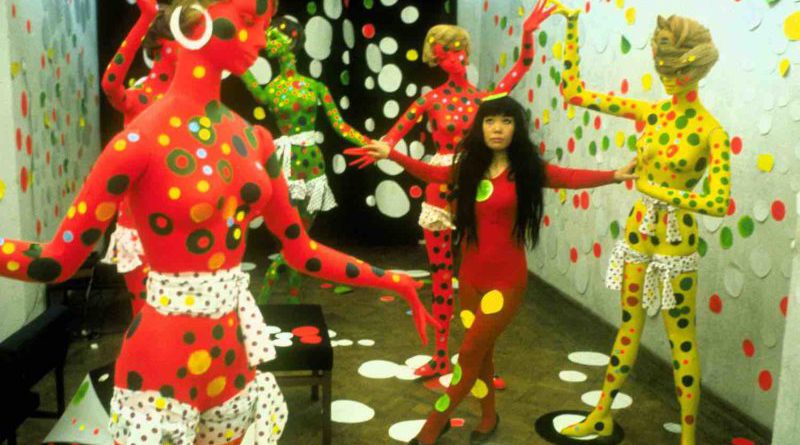REVIEW: ‘Kusama – Infinity’
Photo: Artist Yayoi Kusama poses in the Orez Gallery in the Hague, Netherlands (1965) in Kusama – Infinity. Photo courtesy of Harrie Verstappen / Supplied by Magnolia Pictures / Provided by Film Forum press site.
Yayoi Kusama has lived a remarkable life. The Japanese artist had a tough time presenting her work in the 1960s and 1970s, often facing prejudice and sexism from the established art institutions that favored her male counterparts, but today, she is the most successful living female artist, someone whose exhibitions command long lines at museums around the world.
The new documentary Kusama – Infinity, now playing at New York City’s Film Forum, looks back at the career of the 89-year-old, filling in the blanks on her formative time in Japan and difficult, yet still productive, years of development in New York City.
Fans of Kusama’s popular infinity rooms, an artistic calling card for the artist, may not realize how extensive and diverse her output has been. She paints intricate canvases and sculpts funky-looking couches, in addition to constructing unique infinity rooms that play with perception.
The infinity rooms, which are mirrored rooms that feature suspended balls that seem to replicate forever, are a fun, experiential form of art appreciation. Because of the limited space in the rooms, visitors need to form long lines to check out their reflections and refractions. Case in point: Try to view Kusama’s infinity room at The Broad museum in Downtown Los Angeles. Without arriving super early in the morning, it’s nearly impossible.
Yes, this reporter has waited in that line.
Kusama – Infinity doesn’t deal too much with the infinity rooms and the recent successes of the artist. Those stories are the icing on a story that begins many decades ago, when Kusama grew up in Matsuomoto, Japan, to parents who were ashamed of her quirky artistic tastes. She eventually moved to New York City to be part of the art scene, but she kept finding herself fighting battles to display her work — battles that her male contemporaries never had to fight.
In the late 1960s, at the height of the Vietnam War, she turned quite political with her work. Kusama would stage happenings of naked performance artists around New York City, all in an effort to respect the human body and oppose the war, which she saw as a needless destruction of the human body. The video captured from this time period offers a rare glimpse into the creative process of Kusama, at a time when performance art was dominating her oeuvre.
Kusama never ceases to impress in the documentary, but sometimes the film doesn’t keep up with its subject’s dynamism. Heather Lenz, the producer and director of Kusama – Infinity, sometimes falls short on details, and with its relatively quick running time, there are a few blanks not filled in.
The actual art, much of it bright, multi-colored and featuring dots, pops off the screen, and kudos to Lenz for offering portraits of Kusama’s output that seem to be three-dimensional. The director trains her eye on the work and expertly examines it with the camera; it’s a tough obstacle to present these sculptural objects, these infinity rooms and these paintings on a flat screen, but Kusama – Infinity achieves the necessary depth.
By John Soltes / Publisher / John@HollywoodSoapbox.com
Kusama — Infinity (2018), produced and directed by Heather Lenz, is now running at New York City’s Film Forum. Running time: 76 minutes. Click here for more information and tickets. Rating: 




